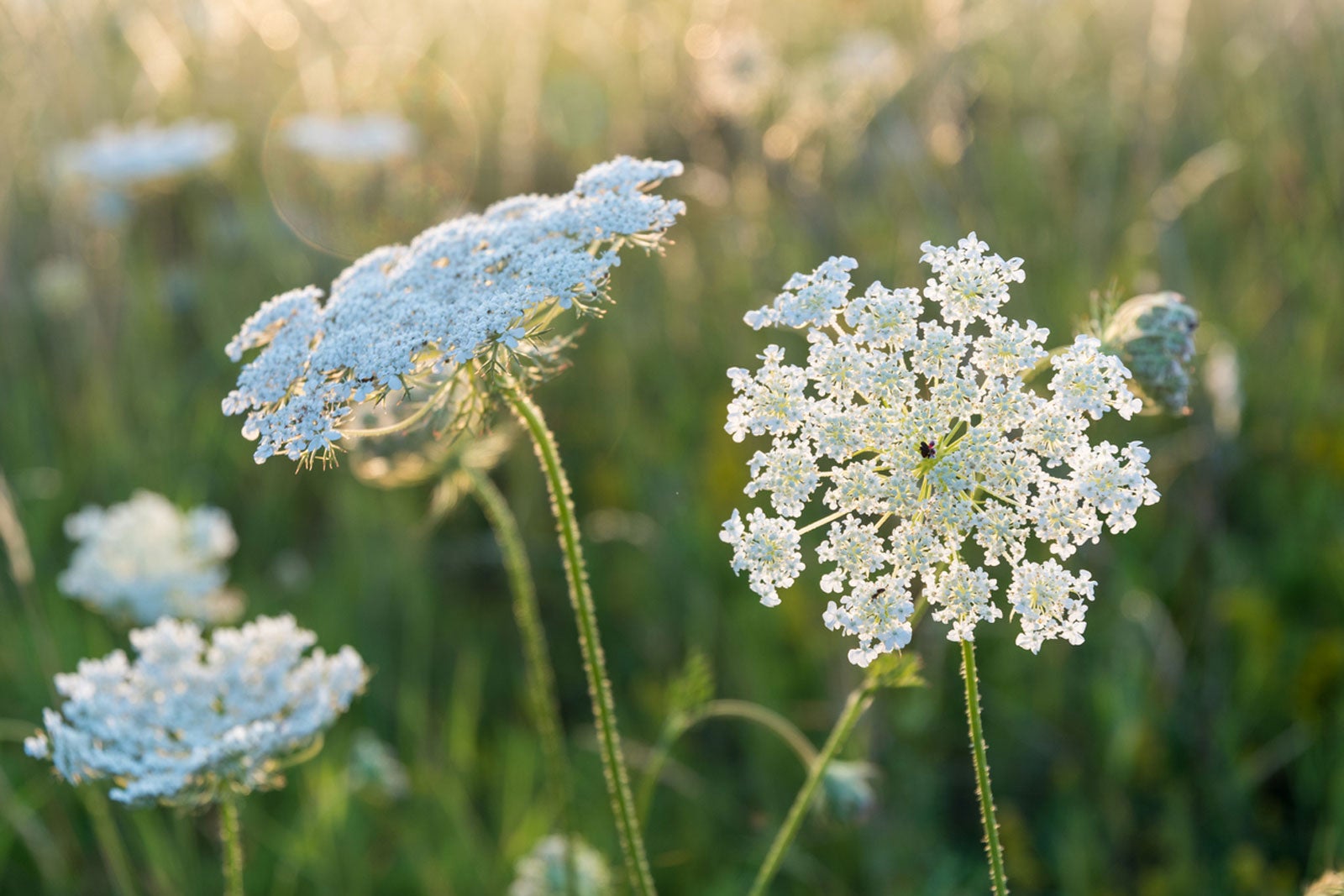meatthesavages.com – Queen Anne’s Lace (Daucus carota), also known as Wild Carrot, is a beautiful and distinctive wildflower that has been captivating gardeners and naturalists for centuries. This delicate flower, native to Europe and parts of Asia, has spread across North America and is often seen growing in fields, meadows, and along roadsides. With its lacy, intricate flower head and soft white blooms, Queen Anne’s Lace has earned its place as a favorite in both wildflower gardens and natural landscapes. Known for its airy, feathery appearance and its ties to both folklore and culinary uses, this plant is both an ornamental beauty and a part of cultural history.
Physical Characteristics
Queen Anne’s Lace is an herbaceous biennial or short-lived perennial that typically grows between 2 to 3 feet (60 to 90 cm) tall, with a spread of around 12 to 18 inches (30 to 45 cm). The plant’s feathery, fern-like leaves are a deep green and are often deeply divided, giving the plant a delicate, lace-like appearance. The flowers are arranged in a flat, umbrella-shaped cluster called an “umbel,” measuring about 4 to 6 inches (10 to 15 cm) across. Each umbel consists of hundreds of tiny, white flowers, with a single deep purple or red flower often found in the center. This distinctive central flower is said to be the “Queen Anne’s” mark, giving the plant its name.
The plant blooms from mid-summer to early fall, attracting a wide range of pollinators, including bees, butterflies, and hoverflies. The flowers eventually give way to small, spiny seed heads that resemble a bird’s nest, which continue to provide interest throughout the autumn months.
Growing Conditions
Queen Anne’s Lace is a hardy and adaptable plant that thrives in well-drained soil, including sandy, loamy, and even somewhat dry soil. It prefers full sun to partial shade and can tolerate a variety of soil types, making it well-suited for natural landscapes and wildflower meadows. The plant grows best in areas with moderate moisture, though it is relatively drought-tolerant once established.
Queen Anne’s Lace is often grown from seeds, which can be directly sown in the soil after the last frost in the spring or in the fall. The seeds require light to germinate, so they should not be buried deeply. Once the plant is established, it will continue to reseed itself year after year, often naturalizing and spreading in meadows, fields, and gardens. While it may take a year or two to fully mature and bloom, the plant’s ability to self-seed ensures its continued presence in the landscape.
Uses in Gardening and Landscaping
Queen Anne’s Lace is a lovely addition to wildflower gardens, naturalized areas, and cottage-style landscapes. It pairs beautifully with other native wildflowers, such as Black-eyed Susans, Coneflowers, and Shasta daisies, creating a soft, naturalistic look. The plant’s airy, lacy appearance makes it an ideal choice for adding texture to garden borders or mixed perennial beds. Queen Anne’s Lace also works well in meadow gardens or xeriscaping, where its drought tolerance and ability to thrive in poorer soils are valued.
The flowers can also be used as cut flowers in floral arrangements, where their delicate, white blooms add a touch of wild beauty to bouquets. The plant’s long, thin stems and feathery foliage provide an elegant, natural touch to garden vases. Its ability to self-seed means that gardeners can enjoy continuous blooms in subsequent years without the need for replanting.
Culinary and Medicinal Uses
Although Queen Anne’s Lace is primarily valued for its ornamental beauty, it has been used historically for both culinary and medicinal purposes. The young roots of the plant are edible and are said to resemble the flavor of carrots, hence its common name, Wild Carrot. In the past, the roots were harvested for use in soups, stews, and herbal teas, though they must be carefully identified, as Queen Anne’s Lace closely resembles the toxic plant, Poison Hemlock. It’s important to never consume the roots unless they have been properly identified by an expert.
In herbal medicine, Queen Anne’s Lace has been used in traditional remedies for a variety of ailments, including digestive issues, urinary problems, and as a diuretic. The plant has a history of being used to relieve menstrual cramps, promote menstrual flow, and as a mild laxative. However, like with any herbal remedy, it is important to consult with a healthcare professional before using Queen Anne’s Lace for medicinal purposes.
Ecological Importance
Queen Anne’s Lace plays an important role in supporting pollinators. Its flat, umbrella-like flower heads are easily accessible to bees, butterflies, and other beneficial insects, which rely on the plant for nectar and pollen. By attracting a variety of pollinators, Queen Anne’s Lace contributes to the overall health of the local ecosystem, making it a valuable plant for biodiversity.
Additionally, its deep taproot allows Queen Anne’s Lace to grow in a variety of soil types, including poor or dry soils, and it can help to stabilize soil and prevent erosion in areas where other plants may struggle to thrive. As a self-seeding plant, it also helps to maintain a constant presence in the landscape, offering valuable habitat for small insects and birds.
Conclusion
Queen Anne’s Lace is a timeless wildflower that combines beauty, ecological benefits, and historical significance. With its delicate, lace-like flowers and ability to thrive in a variety of growing conditions, it’s an excellent choice for gardeners looking to add natural charm and biodiversity to their landscapes. Whether used in wildflower gardens, meadows, or cottage-style plantings, Queen Anne’s Lace provides a soft, airy texture and long-lasting visual appeal. Its culinary and medicinal uses, along with its role in supporting pollinators and promoting soil health, make it a valuable addition to any garden or natural area.
